YEAR-END REVIEW: WELCOME TO THE COUNTER-CULTURE 2021 WISECO WORLD TWO-STROKE CHAMPIONSHIP

Photos by Debbi Tamietti and Trevor Nelson
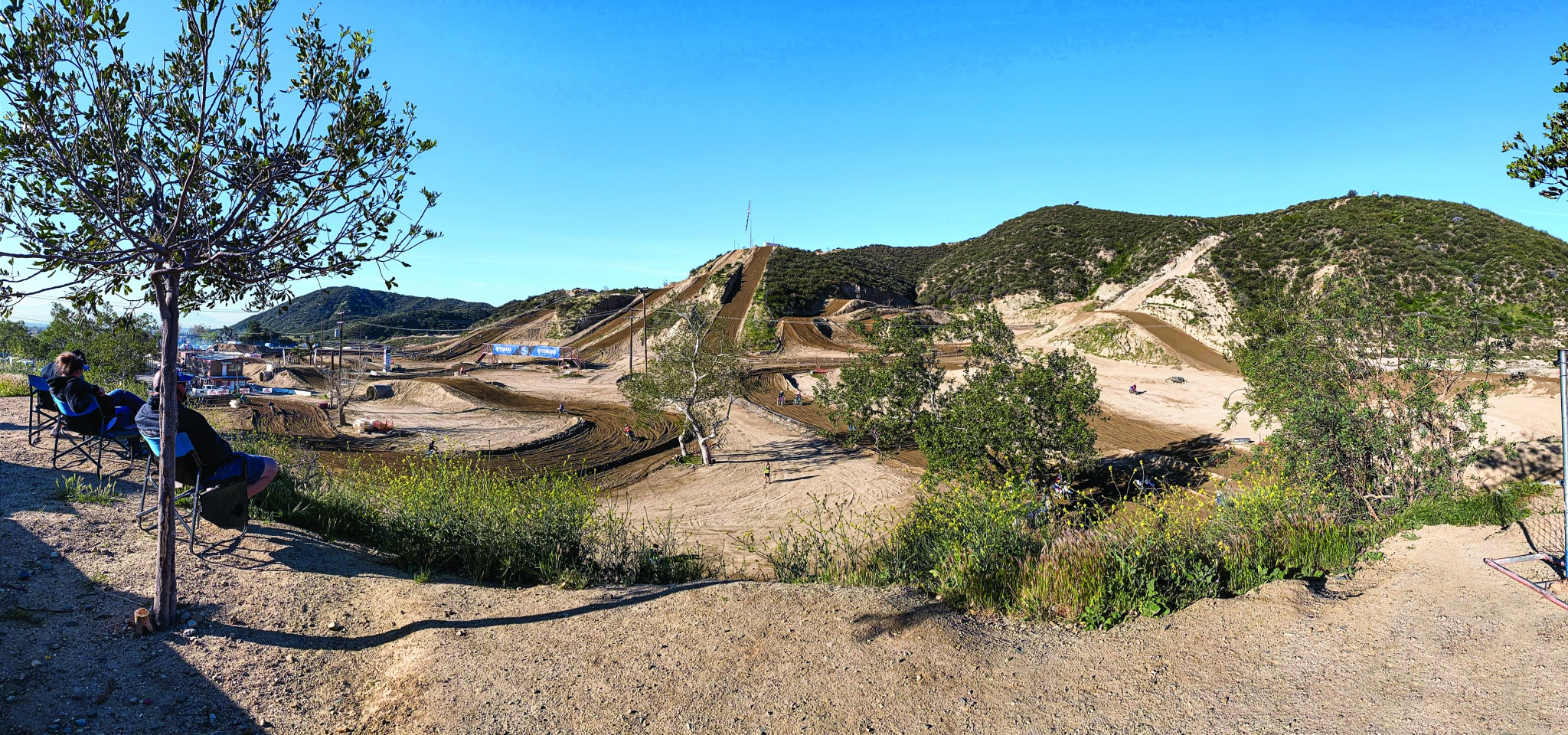
You don’t need Sherlock Holmes to tell you that a two-stroke is a vastly superior motocross racing engine to a four-stroke. On a per-cubic-centimeter basis, it makes 40 percent more power and does it with less weight, fewer moving parts, less cost and without the need for much in the way of technical support. The two-stroke is the ultimate powerplant for a motocross machine. In fact, the two-stroke was so superior to the four-stroke when it made its first mark on racing back in 1966 that it wiped the four-stroke off of the racetracks of the world. And, the two-stroke would most likely wipe the four-strokes off the face of the earth today—if the bureaucrats, fat cats, money changers, pencil pushers, professional alibiers and downright liars weren’t in charge of the direction of the sport of motocross.
THIS SENTIMENTAL YEARNING IS CALLED NOSTALGIA—AND IT IS EASILY TRIGGERED BY A SONG ON THE RADIO, AN OLD MOVIE, FAMILY SNAPSHOTS OR THE SMELL OF TWO-STROKE OIL BURNING.
Ask yourself these questions, why wouldn’t a sport want to push engines that are both more powerful and cheaper to compete on? Why wouldn’t a sport want to make machines less expensive for consumers to buy (and, more important, cheaper to repair)? Conversely, why would a sport want to support engine designs that are so complicated that race-team budgets had to expand by four times to cover the increase in costs? Why would a sport want to ensure the existence of an engine type that favors cubic dollars over common sense?
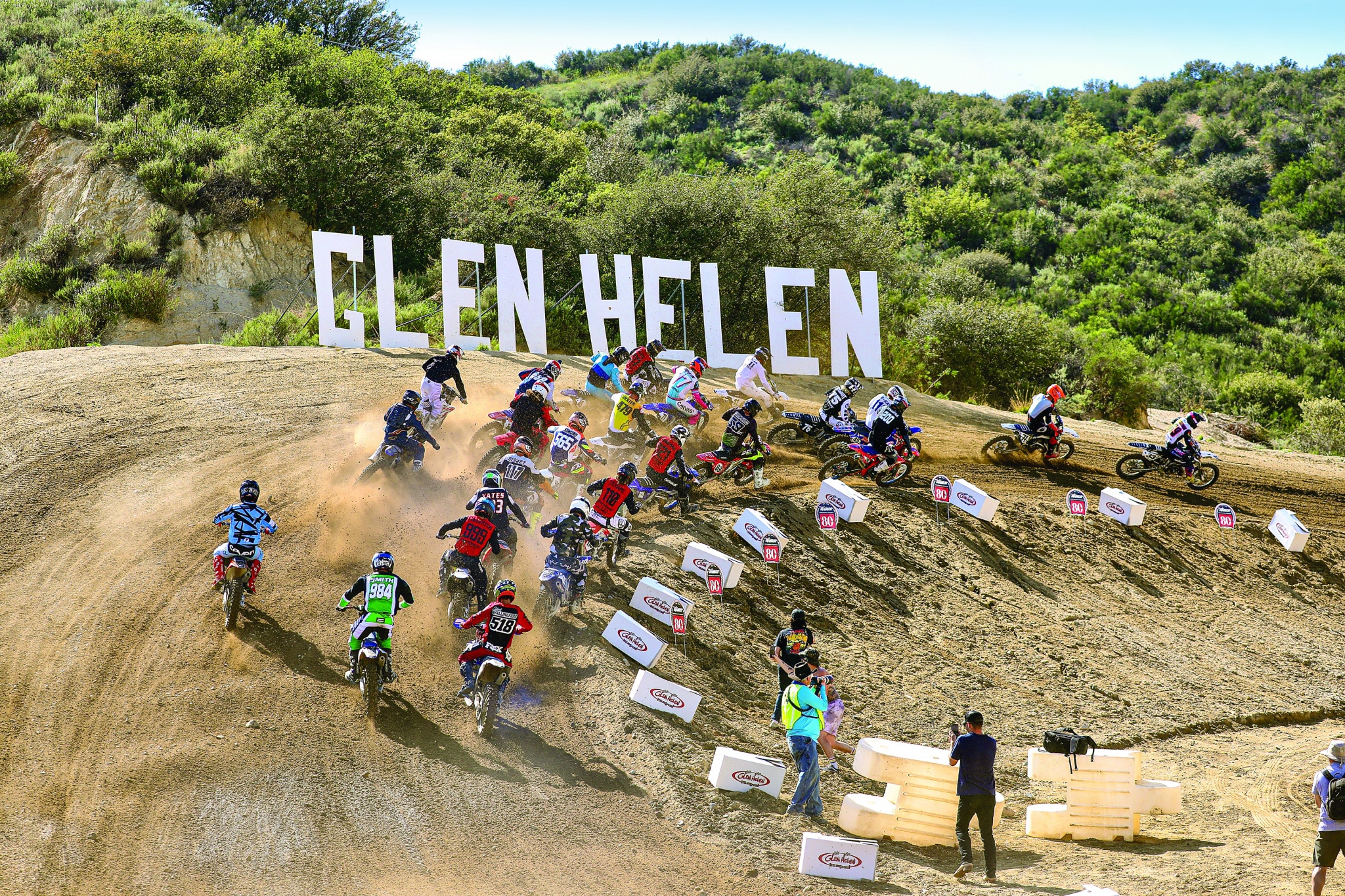 If you want to win at Glen Helen, you need to get around the steeply banked Talladega first turn in the top five.
If you want to win at Glen Helen, you need to get around the steeply banked Talladega first turn in the top five.
We all have a wistful desire to return to the happiness of a former place, time or machine. This sentimental yearning is called nostalgia—and it is easily triggered by a song on the radio, an old movie, family snapshots or the smell of two-stroke oil burning. You don’t have to look very far to see modern throwbacks. In automobile manufacturing, the Ford Mustang, Dodge Challenger and Chevy Camaro are examples of retro-futurism. The home appliances in most modern show kitchens are modern takes on mid-century items like coffee pots, mixers, stoves and fridges. Two-stroke ownership pays homage to the era before politics played such a big role in what we ride, how much it costs and whose pockets are lined from the demise of the two-stroke.
BEING PRO-TWO-STROKE DOESN’T MEAN THAT YOU HAVE TO BE ANTI-FOUR-STROKE. THERE ISN’T A TWO-STROKE ADVOCATE ALIVE WHO WANTS TO RIP A LOYAL FOUR-STROKE OWNER’S BIKE FROM HIS COLD DEAD HANDS. JUST THE OPPOSITE; TWO-STROKE AFICIONADOS WANT TO PEACEFULLY COEXIST
No one can say with any certainty that the two-stroke would save the sport, but it can save the sport for the individual rider who makes the decision to return to the fun days of racing—and a part of that fun is being able to afford it. Many of today’s two-stroke racers believe that the sport took the wrong fork in the road back in 1998 when the AMA handed out a massive displacement advantage to thumpers, without which the four-stroke would still be relegated to play-bike status.
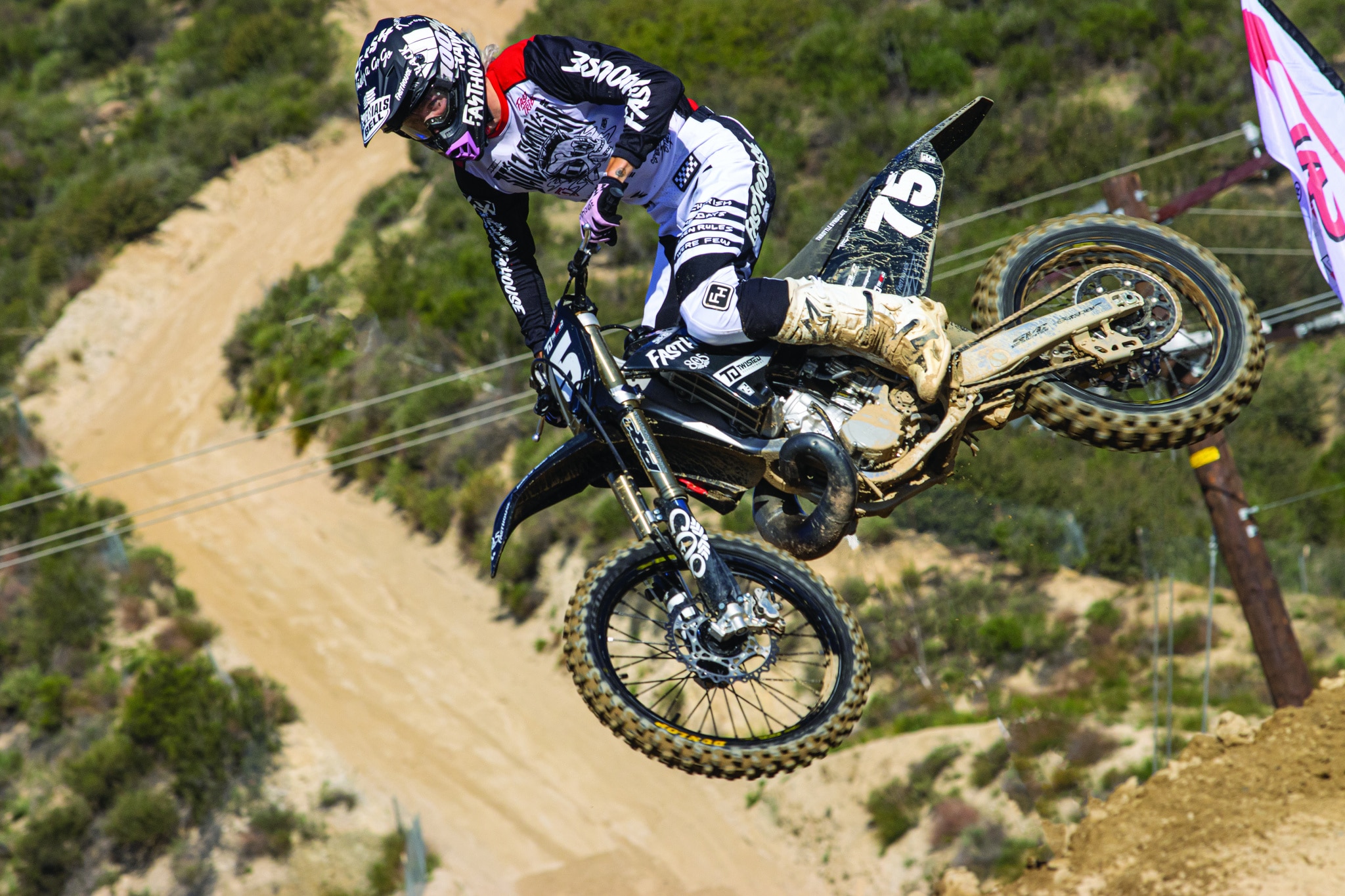 Coulda, shoulda, woulda, but Trevor Stewart didn’t win because he had a 7th in the first Open Pro moto. He easily won the second moto, but ended up 3rd overall.
Coulda, shoulda, woulda, but Trevor Stewart didn’t win because he had a 7th in the first Open Pro moto. He easily won the second moto, but ended up 3rd overall.
Four-strokes, because of their weight, torque and chassis setup, tend to follow the same racing line. It is harder to make cuts on a 450cc machine that weighs 245 pounds than on a 220-pound machine with a light, snappy throttle response. Although all race outcomes are dependent on the talent of the riders in the field, racers on two-strokes can run closer to each other, use different lines and try more exotic strategies than a four-stroke would ever allow.
 MXA’s Josh Mosiman (right) double-classed it with 3rd in the 125 Pro class and 8th in the Open Pro class. Since Josh rode two classes, Schnikey (left) had twice as many bikes to prep.
MXA’s Josh Mosiman (right) double-classed it with 3rd in the 125 Pro class and 8th in the Open Pro class. Since Josh rode two classes, Schnikey (left) had twice as many bikes to prep.
A two-stroke engine does not have cams, buckets, shims, keepers, valves, valve springs, valve seats or finger followers. A two-stroke’s greatest strength is its simplicity. Fewer moving parts translates into a lower price at the dealer level and a machine that can be rebuilt for pennies on the dollar compared to a four-stroke. Best of all, a two-stroke can be rebuilt in the garage by a mechanically inept shoe salesman from Peoria. Try that with a four-stroke!
 Northern Californian Dare DeMartile raced a Beta 300RX to second in the Open Pro class. Amazingly, Dare made the most money because he got paid $5000 start money from Beta, $2500 in bonus money for second and $1200 from the purse money.
Northern Californian Dare DeMartile raced a Beta 300RX to second in the Open Pro class. Amazingly, Dare made the most money because he got paid $5000 start money from Beta, $2500 in bonus money for second and $1200 from the purse money.
First and foremost, being pro-two-stroke doesn’t mean that you have to be anti-four-stroke. There isn’t a two-stroke advocate alive who wants to rip a loyal four-stroke owner’s bike from his cold, dead hands. Just the opposite; two-stroke aficionados want to peacefully coexist on the same track at the same time with the same displacement formula as their four-stroke brothers. But, you should realize at this point in the our sports’ life cycle that two-strokes epitomize what motocross is all about. They are a blast to ride. They wheelie, spin and roost with a raspy sound that doesn’t turn into a deafening roar. The real thrill of racing motorcycles is muted by the drum of a heavy four-stroke engine. Two-strokes can make cuts and go places that four-strokes can only dream of. And, for all the sound advocates out there, they are quieter.
 Justin Hoeft swept both motos of the Pasha 125 Pro class. He earned $3000 in purse money and a $3000 bonus from Fasthouse.
Justin Hoeft swept both motos of the Pasha 125 Pro class. He earned $3000 in purse money and a $3000 bonus from Fasthouse.
As much as Barrett-Jackson auctions highlight the American consumer’s interest in finely crafted vehicles that aren’t necessarily front line, the World Two-Stroke Championship shows respect for the machinery that put motocross on the map. And, don’t let anyone tell you that the sport is better than ever since the advent of the four-stroke era. Back in the 1970s, the motorcycle manufacturers sold one million dirt bikes a year to Americans. Today, they would jump for joy if they sold 100,000. Do you think it had anything to do with the fact that motorcycles in the 1970s were affordable to build, buy, own, maintain and race? That seems like an obvious formula for success.
 Josh Mosiman was third in the Pasha 125 Pro class and collected an extra $250 in holeshot money on his Pro Circuit KTM 150SX.
Josh Mosiman was third in the Pasha 125 Pro class and collected an extra $250 in holeshot money on his Pro Circuit KTM 150SX.
Most motocross fans like to think of modern two-stroke racing as a laid-back, old-school, Woodstock-like get-together of old coots who reminisce about the good old days when two-strokes ruled the world. There is a fair amount of truth to that concept, but two-stokes have made quite a comeback since the days when you couldn’t even sell a used YZ250, CR250, KX250 or RM250 and had to push your trusty smoker into the back of the garage to make room for your new-fangled four-stroke. The two-stroke is back. In fact, if you pushed your YZ250 into the dank, dark corner of your garage back in 2002 because it was considered obsolete, you are in for a surprise. The price of used YZ250s has shot through the roof. Used bikes that were hard to sell at $1000 20 years ago are now topping $5000.
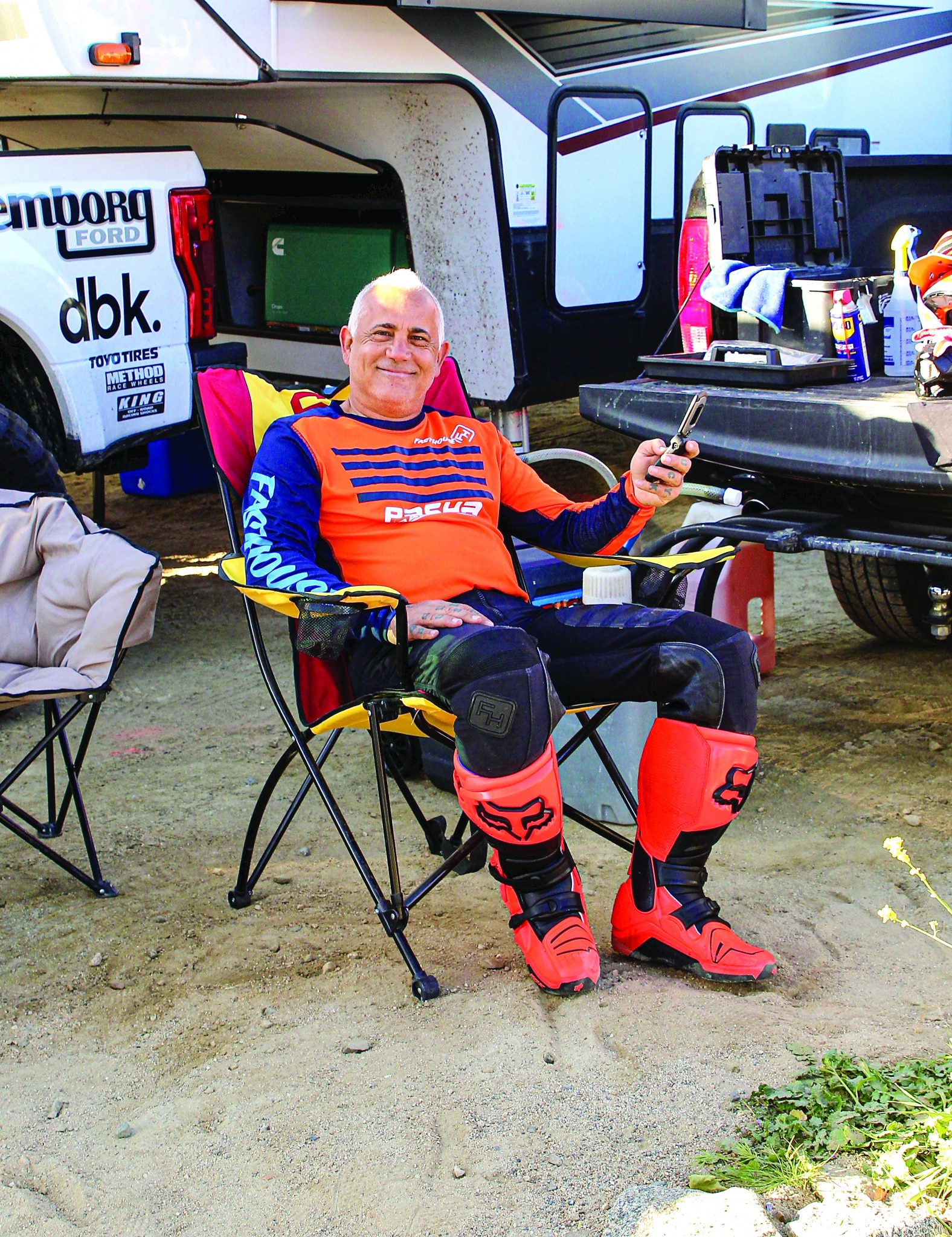 Fun-loving Pasha Afshar put up $10,000 in purse money out of his own pocket for three special 125 Pro races.
Fun-loving Pasha Afshar put up $10,000 in purse money out of his own pocket for three special 125 Pro races.
And the down-home, folksy atmosphere of two-stroke racing is now a big business for aftermarket companies that sell plastic restyle kits, big-bore top-ends, two-stroke exhaust pipes, gold rims, graphics and Old New Stock (NOS). Everybody knows somebody who is restoring “that old dog”—and spending double what it would have cost to buy it new. A walk through the pits at the World Two-Stroke Championship would reveal bikes of incredible build quality that rival the best works bikes of the 1990s. It’s easy to understand why Wiseco sponsored the 2021 World Two-Stroke Championship—those are their best customers. Wiseco knows that the 750 two-stroke bikes at Glen Helen aren’t “Garage Queens.” They are race bikes ridden by men who decided that life was short and perhaps it would be more worth living if they went against the four-stroke grain.
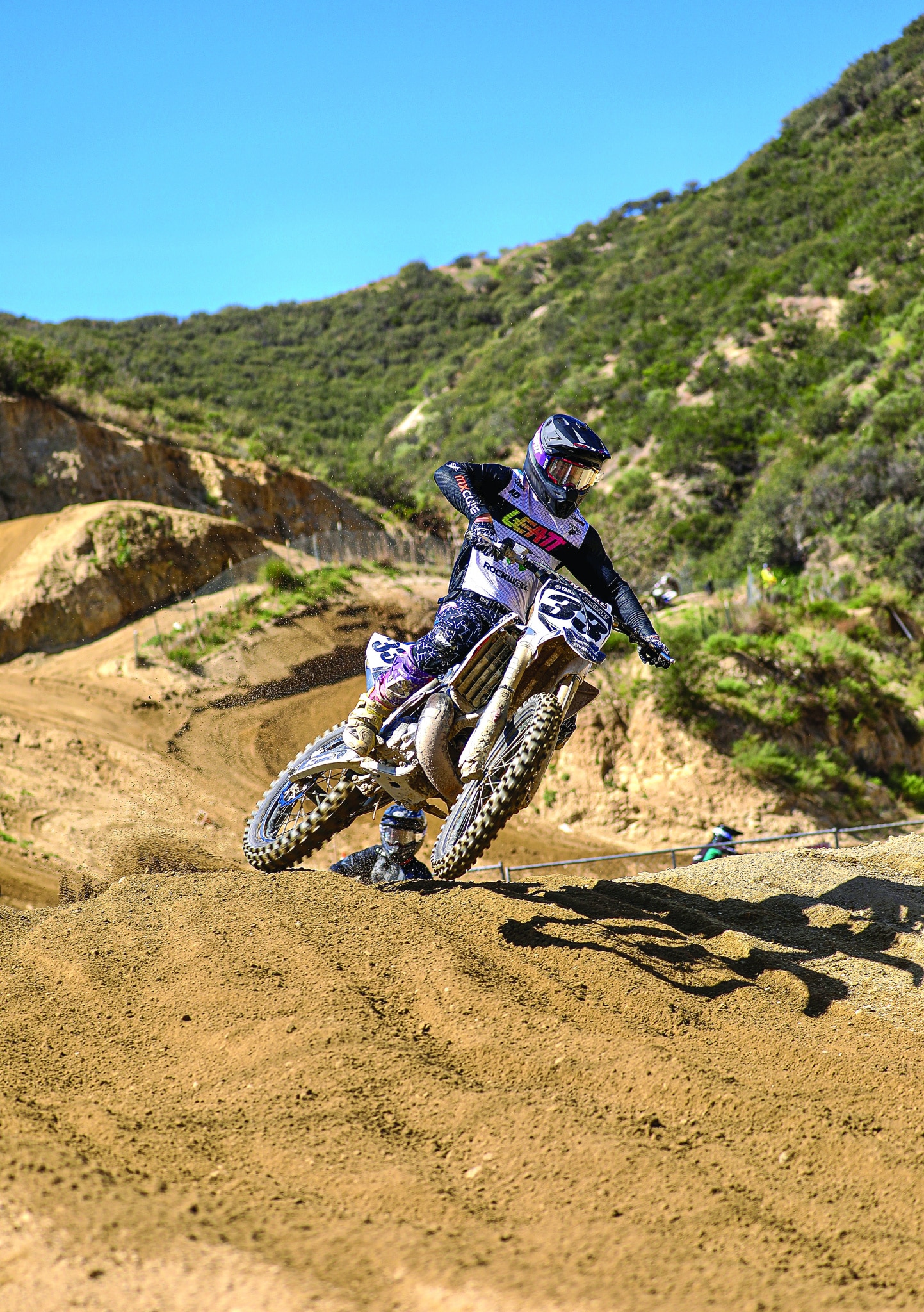 Robbie Wageman came out to watch his brother R.J. race on his off weekend from the AMA 250 West. When Josh Grant got hurt in practice, Robbie was recruited to ride Josh’s bike. Not only did he ride it, but he won the Open Pro class on it.
Robbie Wageman came out to watch his brother R.J. race on his off weekend from the AMA 250 West. When Josh Grant got hurt in practice, Robbie was recruited to ride Josh’s bike. Not only did he ride it, but he won the Open Pro class on it.
The idea of the World Two-Stroke Championship shouldn’t come as a big surprise. Why not? Because this is exactly what happened to four-strokes when they were erased from the face of the earth by the upstart two-strokes back in the late 1960s. Think about it. At one time, the White Brothers World Four-Stroke Championship was the cult enclave for the eccentric fans of antiquated technology (sort of like Model T or Piper Cub reunions). By the mid-1970s, four-stroke equipment was obsolete, thus the idea of a World Four-Stroke Championship took on special meaning as a celebration of “the way it was.” Then, thanks to the rewriting of the 1997 AMA rule book, the world was turned on its head. The lowly, antiquated, overweight, money-burning four-stroke became the darling of the industry, and the light, powerful and simple two-stroke became the outcast.
 Kurt Nicoll (2) won the Pasha Over-50 125 Pro class in a tough race against Doug Dubach.
Kurt Nicoll (2) won the Pasha Over-50 125 Pro class in a tough race against Doug Dubach.
When four-strokes returned from the dead with the Yamaha YZ400, CRF450 and KX450F, the World Four-Stroke Championship lost its cachet as the cool, retro, saving grace of the long-lost BSA era. Thus, it was discontinued in 2010, after 34 continuous years of running, and replaced with the World Two-Stroke Championship. This was the logical move, as the fond memories of four-strokes were displaced by fond memories of two-strokes.
With each passing year, as two-strokes faded from the lives of young fans and racers, the machinery become more iconic in the minds of the hardcore, who wished to preserve the two-strokes—and even see them return. With each passing year, the decade-old World Two-Stroke Championship took on more meaning as the sport got further away from affordable, lightweight and easy-to-maintain motorcycles in favor of increasingly complicated, overly electronic and ridiculously expensive four-strokes.
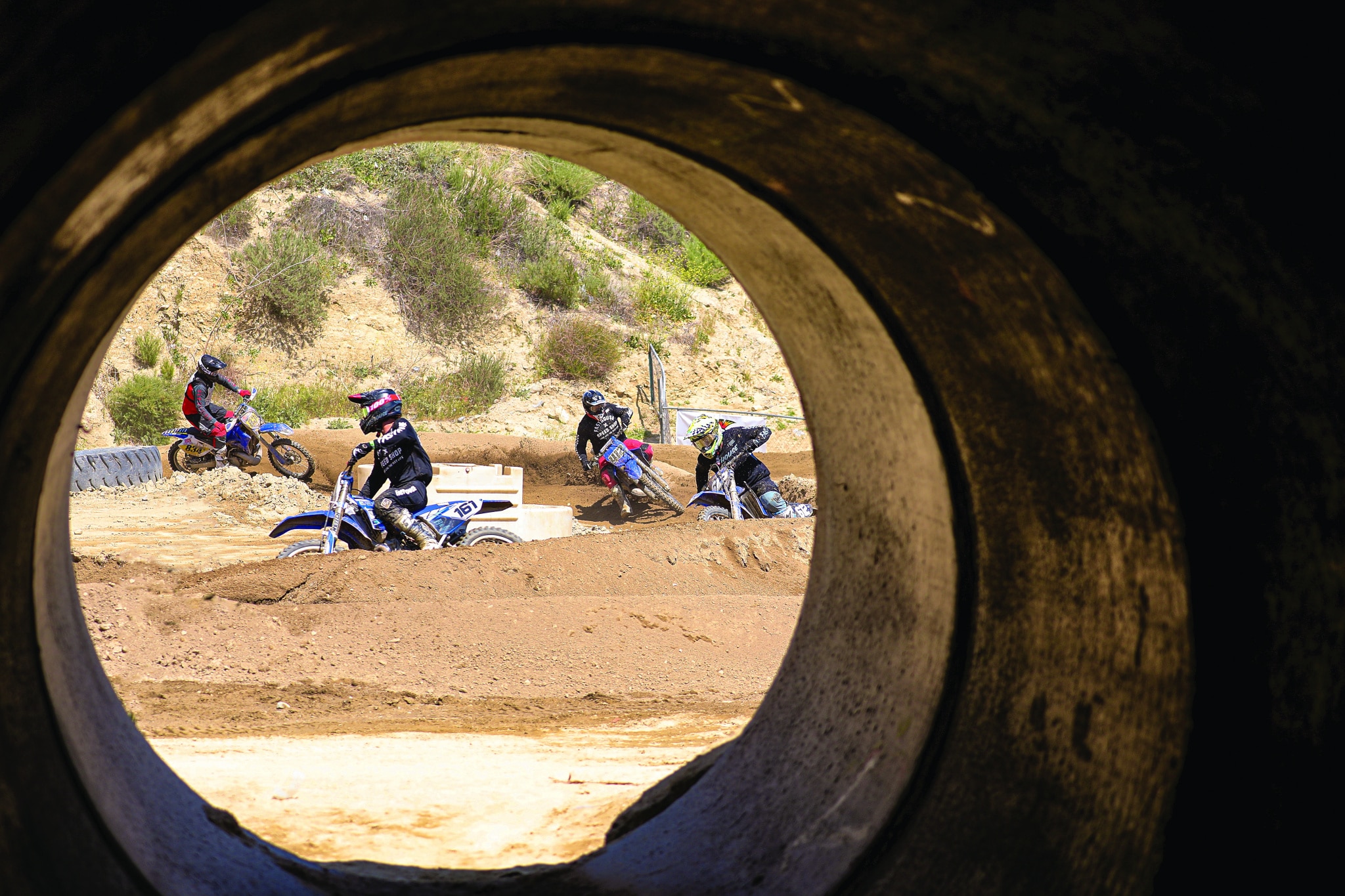 There is always light at the end of the tunnel…and four guys fighting for their spot.
There is always light at the end of the tunnel…and four guys fighting for their spot.
In Europe, they are shocked that anyone would call something a “World Championship” without allowing Giuseppe Luongo to eliminate the purse money, hold it in some backwater country and charge ridiculous entry fees; but, just as with the World Vet Championship, Supercross Championship and the World Two-Stroke Championship, Americans have a history of embracing unique race ideas decades before Europe even recognizes them. Thus, the title goes to the men who plant the flag‚ not the men who copied planting the flag.
In truth, the World Two-Stroke Championship was born when no one else in the world cared about two-strokes‚ and they didn’t care because they couldn’t make a buck from them. So, while the rest of the motocross world went about the business of ruining the sport they inherited, there were still a few small enclaves of rebellion. Doing the exact opposite of what the big manipulators at the AMA, MX Sports, FIM, Infront and the factories want you to do is what is so sweet about the 2021 World Two-Stroke Championships. People show up, not in support of Schnuerle loop scavenging, but in the self-satisfactory jubilation of keeping old-world, cottage-industry technology alive while sticking it to the man at the same time. Ain’t life strange?
 Dare DeMartile, Robbie Wageman and Trevor Stewart.
Dare DeMartile, Robbie Wageman and Trevor Stewart.
TEN WORLD TWO-STROKE NOTES
(1) Josh Grant was the favorite, but he never got the chance to go to the starting line, as he crashed his Twisted Development YZ250 in practice and suffered a concussion and a punctured lung. Luckily for Twisted Development, Robbie Wageman came out to watch his brother R.J. race and was offered Grant’s bike. He went on to win both Open Pro motos and
get $3000 in purse and holeshot money.
(2) Mike Alessi couldn’t defend his 2021 World Two-Stroke Championship because he broke his wrist during the AMA Arenacross series, but his brother Jeff showed up and went 1-2 in the Pasha Over-30 125 Pro class, only to be beaten by Sean Collier’s 2-1. Collier is a former two-time World Two-Stroke Champion (2013-2014). Collier’s win was worth $1000, while Jeff Alessi got $850 in purse and holeshot money.
(3) With Mike Alessi and Josh Grant on the sidelines, Dare DeMartile was promoted to Open Pro favorite, since he had finished second behind Mike Alessi in 2020, even passing Alessi for the first-moto win. Dare got an offer from Beta to race their 2021 300RX. The offer was rumored to be $5000 in start money and additional bonus money for the Glen Helen round. Dare finished second overall on the Beta, and it is guesstimated that his Glen Helen day earned him $8000.
(4) The MXA wrecking crew showed up with eight bikes, with the focus on Pros Josh Mosiman and Jerry Robin in the Pasha 125 Pro and Open Pro classes, while Cole Zeller would race the Pasha 125 Pro class. Australian Dan Alamangos was in the Pasha Over-50 125 Expert class, and John Perry raced the Pasha Over-50 125 Pro class. Josh Mosiman went 2-3 in the 125 Pro class on a Pro Circuit-tuned KTM 150SX and 4-10 in the Open Pro class on a stock Husky TC250. Jerry Robin raced MXA’s YZ250 to a 3-9 finish in the Open Pro class and went 4-4 in the Pasha 125 Pro class on MXA’s stock GasGas MC 125. Cole Zeller raced MXA’s box-stock 2021 KTM 150SX to 7-7 scores in the Pasha 125 Pro class. Additionally, MXA’s Dennis Stapleton went 3-4 in the Pasha Over-30 125 Pro class.
(5) There were three special riders at the World Two-Stroke Championships. Think of them as the riders who came to dinner: (1) Hillbilly impersonator Ronnie Mac made a brief but embarrassing appearance on the start of a race. (2) Freestyler Jeremy “Twitch” Stenberg went 4-3 for third in the Over-40 Expert class. (3) Vicki Golden finished 17th in one moto in the Pasha 125 Pro class and won the Women’s class.
(6) Off-road racer Trevor Stewart could well have won the Open Pro class, but a crash early in the first moto left him at the back of the pack, where he raced back to 7th by the moto’s end. Trevor then won the second moto, but his 7-1 was only good enough for third overall.
(7) Brit Kurt Nicoll and Doug Dubach continued their almost decade-old feud that started at the World Vet Championship when they were in their 40s. They weren’t half a lap into the first moto of the Over-50 Pasha 125 Pro race before they both had run into each other in two different corners. By day’s end, Nicoll had gone 1-1 over Dubach’s 2-2, but the big surprise was that last year’s Over-50 Pasha 125 winner Pete Murray got passed for the last spot on the podium by South African Alan Jullien in the second moto.
(8) The track featured everything that Glen Helen is famous for—the 70-mph start straight; the 45-degree-banked, 180-degree Talladega first turn; a 220-foot vertical climb to the top of Mt. Saint Hill; a whistling-fast downhill into a two-lane sweeper; the return of the Saddleback humps in the Canyon section, followed by the most difficult obstacle for most World Two-Stroke riders—a wide, downhill, off-camber, 180-degree turn where gravity pushed the riders down to the bottom, a mellowed-out triple step-up and two sets of rolling whoops (one in the sand section below the REM pit and the other over by the start).
(9) The fastest Pro lap of the day was turned in by Jerry Robin in the first moto of the Open Pro class, it was a blistering fast 2.39.8. Pasha 125 Pro winner Justin Hoeft did a 2:42.2, Sean Collier put in a 2:47.9 in the Over-30 125 Pro class while Doug Dubach clocked a 2:56.7 in the Pasha Over-50 Pro class. The fastest lap time by a non-Pro was 2:47.1 by 250 Intermediate Slade Varola. The vast majority of riders couldn’t break the 3-minute lap-time mark, and second moto times were 5 to 10 seconds slower than first moto times.
(10) The 750 two-stroke riders at Glen Helen came from England, France, Australia, Canada, Ireland, Japan, Mexico, the United States and South Africa. The states with the most riders were, in order: California, Arizona, Colorado, Nevada, Washington, Texas, Utah, Florida, Minnesota, Montana, New Mexico, Oregon, Tennessee, Texas and Utah.
RESULTS: 2021 WISECO WORLD TWO-STROKE CHAMPIONSHIP
 Jerry Robin (77) raced MXA test bikes to 4th in the 125 Pro class and 6th in the Open Pro class.
Jerry Robin (77) raced MXA test bikes to 4th in the 125 Pro class and 6th in the Open Pro class.
OPEN PRO
1. Robbie Wageman (Yam) 1-2
2. Dare DeMartile (Bet) 2-3
3. Trevor Stewart (Yam) 7-1
4. Brandon Ray (Yam) 5-4
5. Griffin Dexter (Hus) 6-6
6. Jerry Robin (Yam) 3-9
7. Sean Collier (Yam) 9-5
8. Josh Mosiman (Hus) 4-10
9. Jason Potter (Hon) 8-8
10. R.J. Wageman (Yam) 10-7
 Brandon Ray (119) was second in the Pasha 125 Pro class and 4th in the Open Pro class.
Brandon Ray (119) was second in the Pasha 125 Pro class and 4th in the Open Pro class.
PASHA 125 PRO
1. Justin Hoeft (Yam) 1-1
2. Brandon Ray (Yam) 3-2
3. Josh Mosiman (KTM) 2-3
4. Jerry Robin (Gas) 4-4
5. Griffin Dexter (Hus) 6-5
6. Ryan Surratt (Hon) 5-6
7. Cole Zeller (KTM) 7-7
8. Sean Borkenhagen (Kaw) 8-8
9. Max Groom (Suz) 9-9
10.Travis Damon (Hon) 10-10
PASHA 125 PRO OVER-30
1. Sean Collier (Yam) 2-1
2. Jeff Alessi (Yam) 1-2
3. Jeff Loop (Hus) 4-3
4. Dennis Stapleton (KTM) 3-4
5. Ricky Yorks (KTM) 8-6
6. Jason Lutton (Yam) 7-7
7. Brian Hulsey (Yam) 6-8
8. Casey Casper (Hon) 10-5
9. Michael Smith (Yam) 9-9
10. Dominic Desimone (Hon) 5-15
PASHA 125 PRO OVER-50
1. Kurt Nicoll (KTM) 1-1
2. Doug Dubach (Yam) 2-2
3. Alan Jullien (Yam) 4-3
4. Peter Murray (Yam) 3-4
5. Kevin Barda (Yam) 5-5
6. Danny Bonham (Yam) 7-6
7. John Perry (Yam) 9-7
8. Steve Chandler (KTM) 8-8
9. Jeff Policky (Yam) 10-9
10. Gary Sailors (KTM) 11-10




Comments are closed.